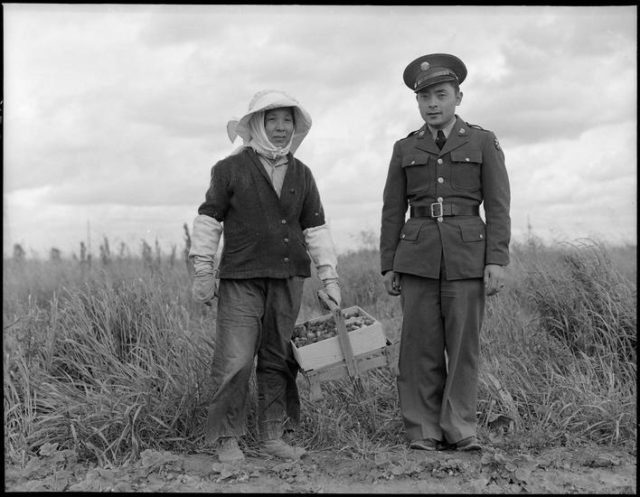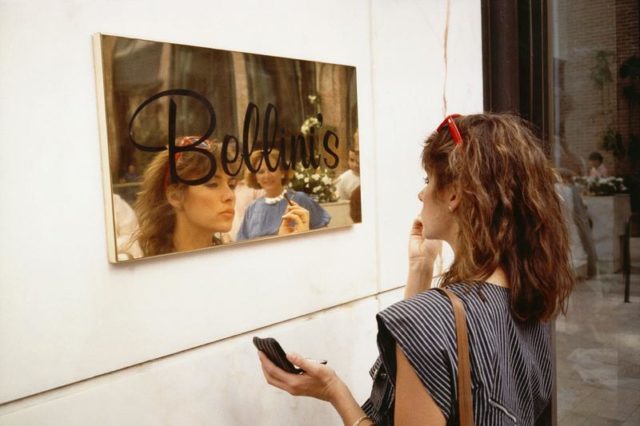
John Divola, Untitled (woman watering, striped top), 1971–73, Vintage gelatin silver print (Courtesy the artist and Marianne Boesky Gallery)
Golden State
Marianne Boesky Gallery
507 West 24th Street
New York, NY
On view until April 27, 2017
Artists: John Divola, Buck Ellison, Christina Fernandez, Anthony Hernandez, Dorothea Lange, Catherine Opie, and Larry Sultan
As a New Yorker, much of my conception of California is filtered through films and TV. At least recently with the popularity of HBO’s Little Big Lies and the continued guilty pleasure of the Real Housewives franchise, California looks like it’s made up of big houses, bigger drama and staggering affluence. But, in addition to the extreme privilege in Orange County, Beverly Hills and Monterey, the state, according to Census research, also has the highest poverty rate in the nation.
Curator Drew Sawyer takes aim at this divide through deceptively simple means in his group photography exhibition Golden State at Marianne Boesky Gallery. Sawyer juxtaposes both staged and documentary style representations of enormous wealth with lack to showcase both individual and communal aspirations. Now, this is a recipe for a pretty standard show, but what makes Sawyer’s approach stand out is how his juxtapositions give us greater insight into a less pictured part of California–not just lower income neighborhoods, but the social and governmental structures that support them.

Dorothea Lange, Florin, Sacramento County, California. A soldier and his mother in a strawberry field, 1942, Inkjet print (Courtesy the artist and Marianne Boesky Gallery)
Featuring seven photographers who either currently live or, at one time, lived in California, the exhibition challenges the romanticized notion of California as a world of fun, sun and astronomical privilege right away. The closest photograph to the entrance depicts a Japanese-American soldier in uniform standing next to his mother who holds a basket of strawberries. While the shot initially looks like a typically awkward scene between mother and son, the photograph is a part of Dorothea Lange’s series from 1942 on Japanese internment camps. The soldier, more than just caring for his mother, is preparing his family for relocation, according to the caption in the National Archives.
The photograph, as well as the two other inclusions from Lange’s series, are, in many ways, anachronisms in Golden State. Her series dates around thirty years before the next earliest works in the show (John Divola’s photos from 1971-1973). But, Lange’s series seems to form the exhibition’s critical backbone. It gestures toward a history and people that are often willfully forgotten.

Anthony Hernandez, Rodeo Drive #3, 1984, Vintage cibachrome print (Courtesy the artist and Marianne Boesky Gallery)
Other works revel in California’s idealism as seen in a grid of six cinematic images of 1980s Rodeo Drive by Anthony Hernandez. In one image, Rodeo Drive #3, a heavily made-up, chic woman fixes her makeup in a gilded plaque for Bellini’s as an older woman, reflected in the sign’s golden glow, grins approvingly. Another photograph presents a well-dressed couple walking arm in arm in front of a Cartier boutique. Overall, Hernandez’s street series captures a familiar view of stereotypical Californian consumerism and superficiality. With its branded excess, the photos look as if they could represent a 1980s version of Keeping Up With The Kardashians.
The Rodeo Drive images come as an almost shocking contrast to the underlying horror of Lange’s pieces, which speaks to the larger organization of the show. While all the photographs are set within one state, their imagery is anything but cohesive. In fact, it looks as if each photographer’s chosen subjects come from a completely different universe.

Anthony Hernandez, Public Transit Areas #10, 1980
Inkjet print (Courtesy the artist and Marianne Boesky Gallery)
California’s architecture and infrastructure also seems to reinforce these boundaries. Take, for example, the suburban banality of John Divola’s early 1970s black-and-white portraits of casually dressed housewives or their overweight spouses watering their perfectly manicured lawns and washing their cars. Presented in sets, the subjects’ duplicate poses suggest a kind of uniformity of culture. In many ways, these images represent exactly what we’ve come to think of as California—sprawling track housing for a population that seems relaxed and content with their lives. What these photographs only occasionally hint at is how car culture supports this lifestyle—an aspect of California living inaccessible to the poor. We see how profoundly this culture affects the poor in Hernandez’s 1979 series of photographs at Los Angeles bus stops which picture low-income city dwellers waiting for public transportation underneath massive billboards and highways the extend well beyond the horizon. The freeways are the way out of these decrepit places, yet the photographs present little hope. They are pictures about the people who have been left behind and their long gazes into the horizon suggest they know it.
And that’s exactly how Sawyer achieves his relevant point. The success of the show derives directly from the curator’s adept juxtapositions of photographs. All curators claim to create a conversation between works, but, here, there seemed to be a visible dialogue between the inclusions’ concept and aesthetic.

Buck Ellison, Hummus, 2015, Archival inkjet print (Courtesy the artist and Marianne Boesky Gallery)
This could be seen most apparently in the comparison between Buck Ellison’s monumental staged Hummus and the adjacent two photographs from Christina Fernandez’s series Lavanderia. Hummus portrays two teenage girls (with another mystery figure in the background) snacking on a bowl of hummus and a plate full of vegetables. Rather than sitting on the nearby stools, the girls are plopped, one with bare feet, right on the pristine marble countertop, obvious to its costliness.
Alternately, Fernandez’s Lavanderia #4 and #11 document the illuminated interiors of East L.A. laundromats as captured through their smudged, graffiti-scrawled windows at night. Among the lines of washers, driers and random bottles of detergent, the bodies of anonymous patrons are blurred as they pull clothes out of the washers or wait for their laundry.

Christina Fernandez, Lavanderia #11, 2003, Chromogenic print (Courtesy the artist and Marianne Boesky Gallery)
While individually, both works perfectly exemplify their depicted economic class: Hummus as the organic-eating, white upper middle class and Lavanderia as the primarily Latino/a lower class. Together, though, these photographs reveal the economic striation in California through their relationship with the state’s popular visual identity. The teen girls are the epitome of domestic leisure in a luxury private space, a vision of West Coast suburbia that should feel familiar to anyone who watched The Hills or The O.C. However, Fernandez’s laundromat, as well as the figures performing domestic labor in the utilitarian commercial space, feels relatively unique (at least for California). The side-by-side comparison of staged and documentary photography too seemed to formally connote class–highly staged photographs appeal to collectors of contemporary art in part due to their inherent high production means. In contrast, documentary photography, like Fernandez’s, is available to everyone.
And it was these moments, which occurred throughout the show, that made Golden State feel fresh. While the photographs themselves may not be breaking out of their respective genres, the curatorial vision made some strides in revising the typical depiction of California as a wealthy monoculture. Did the exhibition–a deadpan show presenting our similarities and differences in equal measure–achieve much more than that? Maybe not. But, it’s a rare and needed vision–so much so that I left even a tad more hopeful than when I arrived.


Comments on this entry are closed.